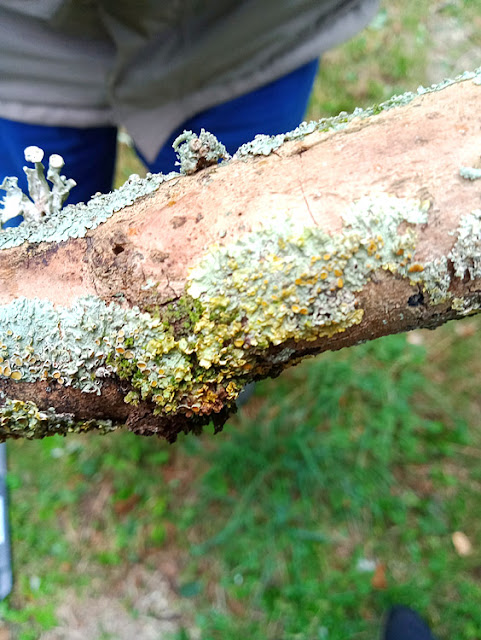 |
| Marie-Claude identifying a lichen she has prised off this riverside ash tree. |
At the beginning of the year I suggested to the Association de botanique et de mycologie de Sainte Maure de Touraine that we have an outing to look at lichens on my friends Tim and Pauline's property in the Aigronne Valley. It was set for 22 October, so my lichen expert friend Marie-Claude thought it was about time we did an initial survey in preparation for the outing.
 |
| Marie-Claude checking out some lichen on a piece of fallen tree branch. |
Well, were we in for a shock. Because the site is run like a small private nature reserve it never occurred to me that it would not be brimming with lichen of all sorts, including rarities. But this is not at all the case. In a quick survey of a couple of hours we only found a couple of dozen species, and most of them were crustose, which are not ideal for a teaching outing, as their details are too small for beginners to really be engaged by. There were very few of the big show foliose types which are excellent for impressing beginners with how lovely and intriguing lichens are. Trees that should have been covered in lichens had a few desultory patches.
 |
| One of the most pollution tolerant lichens, Common Orange Lichen Xanthoria parietina, showing some rather old and discoloured apothecia (spore bearing structure). |
Marie-Claude's assessment is that the lichens are missing because of agricultural pollution, specifically nitrates. The species that were present were all nitrogen lovers, or those that could tolerate nitrogen. Those that were sensitive to nitrogen were simply not present. It seems likely that there is excess nitrogen present in the air, water and soil, due to modern farming practices. Instead of the meagre 20 species we recorded, if the site had been unpolluted, we would have found twice the number of species.
 |
| The foliose Common Orange Lichen, demonstrating its habit of going orange in the sun and green in the shade. This branch obviously has patches of both. |
It was very depressing, and all Tim and Pauline's work is being ruined by the actions of surrounding farmers. When I got home I emailed Yohann, our local river technician. He takes a particular interest in the Aigronne Valley and Tim and Pauline's place particularly. I knew he'd be interested, and depressed, as I was. I asked him about what water pollution levels he or his colleagues had measured and if I've understood the tables of figures correctly, this is what they revealed:
86% of land along the Aigronne is put to agricultural usage. The river is considered to be at medium risk of pesticide pollution and at high risk of nitrate (NO3) pollution increasing over the current level recorded at 34mg/litre.
 |
| The crustose Script Lichen Graphis scripta. |
Further reading told me that the level of nitrate considered natural and normal is 1-2 mg/litre and anything over 10mg/litre is considered to be hazardous. The nitrates in agricultural environments are salts formed by nitrogen containing fertilizers reacting with oxygen. Easily dissolved in water they can cause eutrophication, where algal blooms occur, then decompose, depleting oxygen in the water and killing organisms like fish that require well oxygenated water to live.
As a consequence of all this, we have decided to hold the outing on 22 October at the Pierre Percée, an ancient standing stone near Draché, which is covered in lichen, and surrounded by maple trees that have a nice range of species too.

1 comment:
Off topic - On Ken’s blog this morning there is a dandelion flower which led me searching the different parts of that flower. (I thought it looked like the chicory flower.) I ended up on this site:
http://www.orchidee-poitou-charentes.org/article970.html
You probably know it, but I thought, just in case, as they say, better safe than sorry!
Post a Comment